The Emerging Role of the Bioengineered Allogeneic Bone Graft (BIB) in Orthopedics and Bone Surgery
Bioengineered allogeneic bone grafts, commonly referred to by the acronym BIB, represent a significant innovation in the field of orthopedic surgery and bone repair. These grafts are developed in a laboratory setting and are derived from donor tissue, which is then treated to make it safe and effective for transplant into different patients. As the medical community continues to advance in its efforts toward regenerating and repairing skeletal defects, BIBs offer a promising alternative with potential benefits over traditional methods.
Understanding Bioengineered Allogeneic Bone Grafts
Bioengineered allogeneic bone grafts are designed to mimic the structure and biological function of natural bone while avoiding complications associated with autografts (bone harvested from one’s own body) or allografts (bone harvested from a donor). BIBs make use of donor tissue but are engineered to remove cellular elements that could cause immune reactions. This results in an osteoconductive scaffold—a structure that facilitates new bone growth—that can contain growth factors or be seeded with cells to further enhance its effectiveness.
The Advantages of Using BIBs in Surgery
One of the key advantages of BIBs lies in their reduced risk of disease transmission and host immune response due to their highly processed nature. Additionally, since they are readily available and do not require a second surgical site for harvesting, as is the case with autografts, they reduce overall patient morbidity. Moreover, BIBs can be produced in various shapes and sizes, which makes them suitable for a wide range of applications, from small defects to large structural scaffolds needed in spinal fusion surgery or major bone reconstruction.
Common Applications for BIBs in Clinical Settings
BIBs have increasingly found a meaningful place in the clinical management of various orthopedic conditions. They are mainly utilized in:
– Cases where bone defects are created following the removal of bone tumors
– Healing critical-sized bone defects that cannot repair themselves
– Bone loss scenarios consequent to trauma or infection
– Spinal fusion surgeries where extensive bone grafting is needed
– Joint revision surgeries where previously implanted material needs replacement
Challenges and Considerations in the Use of BIBs
Despite their growing popularity, BIB usage comes with its set of challenges and considerations. The process of designing a scaffold that adequately provides mechanical support while promoting bone ingrowth is complex. Furthermore, the absence of living cells within some variants of BIB might impede the process of bone healing compared to autografts, which contain osteogenic cells.
Also, there’s still ongoing debate and analysis concerning the cost-effectiveness of BIB impregnated with growth factors or stem cells due to the higher price points associated with these advancements.
Future Developments and Research Directions
There is active ongoing research focused on enhancing bioengineered allogeneic bone grafts, particularly pertaining to 3D printing technologies and the incorporation of stem cells and biomolecules. Through these avenues, scientists aim to create even more advanced constructs that better facilitate osteointegration and further tailor them to patients’ specific needs.
Notes
*Image description: A selection of bioengineered allogeneic bone graft samples lies on a sterile workbench with laboratory equipment in the background, displaying various shapes and sizes suited for different orthopedic applications.*
